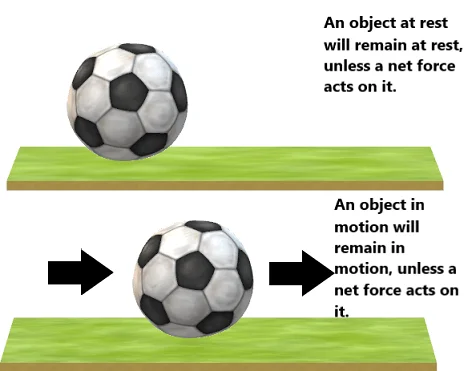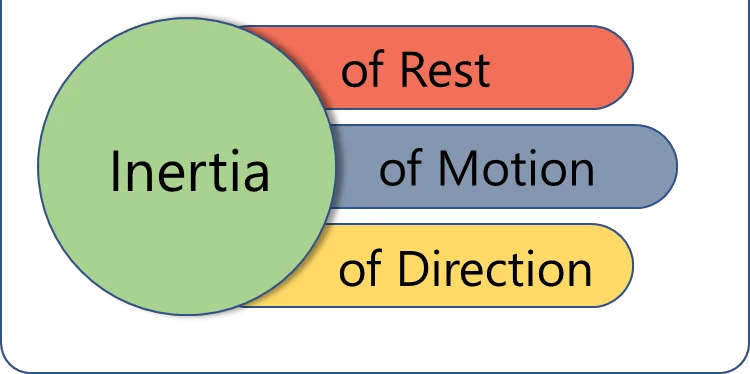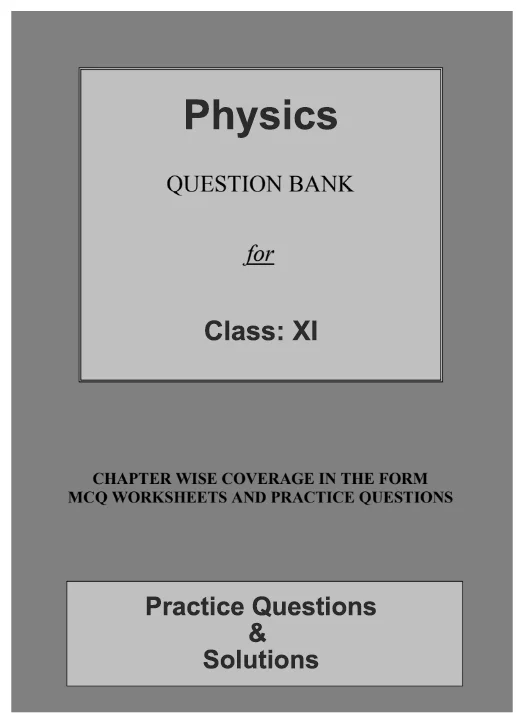In the world of Physics, Sir Isaac Newton is the man who pioneered classical physics with his laws of motion. In these laws, the first law is also known as the Law of Inertia. Law of inertia is the most important and renowned one. In this piece of article, let us discuss the first law of inertia in detail.

What is The law of inertia?
The Law of Inertia, a fundamental principle in physics, states that an object at rest remains at rest, and an object in motion continues in motion with a constant velocity unless acted upon by a net external force. In simpler terms, it describes the natural tendency of objects to maintain their state of motion or rest unless an external force compels them to change. This concept is one of Sir Isaac Newton's three laws of motion, forming the basis for classical mechanics. The inertia of an object is directly related to its mass—the greater the mass, the greater the inertia.
Galileo’s Free Fall Experiment:
Galileo Galilei's free fall experiment was a groundbreaking investigation that revolutionised our understanding of motion and gravity. In the late 16th century, Galileo conducted experiments at the Leaning Tower of Pisa to study the motion of falling objects.

Key Aspects of Galileo's Free Fall Experiment:
Hypothesis: Galileo proposed that in the absence of air resistance, objects of different masses, when released simultaneously from the same height, would fall and hit the ground at the same time.
Experimental Setup: Galileo's experiment involved dropping objects of various masses from the Leaning Tower of Pisa. To eliminate the effects of air resistance, he chose objects that were dense and streamlined, such as spheres.
Observations: Contrary to popular belief at the time, Galileo observed that all objects, regardless of their masses, fell and reached the ground at nearly the same time. This was a significant departure from the Aristotelian view that heavier objects fall faster.
Concept of Uniform Acceleration: Galileo's work laid the foundation for the concept of uniform acceleration. He realised that, in the absence of air resistance, the only force acting on a falling object is gravity, causing it to accelerate uniformly.
Mathematical Formulation: Galileo formulated mathematical relationships describing the distance covered by a falling object in relation to time. This laid the groundwork for the later development of kinematics and dynamics.
Types of Inertia:
Inertia is the resistance of an object to changes in its state of motion. There are three main types of inertia:

Inertia of Rest:
Explanation: An object at rest tends to remain at rest unless acted upon by an external force. This type of inertia is evident in situations where objects, initially at rest, resist any change in their stationary state. For example, a stationary book on a table will stay in place until an external force, like someone pushing it, acts upon it.
Inertia of Motion (or Uniform Motion):
Explanation: An object in motion tends to remain in motion with the same speed and in the same direction unless acted upon by an external force. This type of inertia is observed when moving objects maintain their velocity and trajectory without any external influence. For instance, a ball rolling on a smooth surface will keep rolling indefinitely unless a force, such as friction or a person's hand, slows it down or changes its direction.
Inertia of Direction (or Angular Inertia):
Explanation: This type of inertia is associated with rotational motion. An object rotating about an axis tends to continue rotating unless acted upon by an external torque. A spinning top, for example, will continue to spin on its axis due to its inertia of direction. External forces, such as air resistance or friction, may eventually cause it to slow down and stop.

Example of The law of inertia:
Car Suddenly Stops:
Scenario: Imagine you're in a car, and the driver applies the brakes suddenly.
Application of Inertia: As the car stops abruptly, you might feel yourself leaning forward. This is because your body tends to stay in motion with the car's previous speed, and when the car decelerates, your body continues forward until an external force (like the seatbelt) acts on you.
Sliding on Ice:
Scenario: On an icy surface, you slide and eventually come to a stop.
Application of Inertia: As you slide, your body is in motion. When you stop sliding, your body wants to keep moving, but the friction between your shoes and the ice provides the external force that brings you to a halt.
Jumping off a Moving Swing:
Scenario: While swinging, you decide to jump off.
Application of Inertia: As you jump off, your body continues moving with the swing's velocity. This is why you might land a short distance away from the swing's point of release.
CBSE Class 11th Downloadable Resources:
| 1. CBSE Class 11th Topic Wise Summary | View Page / Download |
| 2. CBSE Class 11th NCERT Books | View Page / Download |
| 3. CBSE Class 11th NCERT Solutions | View Page / Download |
| 4. CBSE Class 11th Exemplar | View Page / Download |
| 5. CBSE Class 11th Previous Year Papers | View Page / Download |
| 6. CBSE Class 11th Sample Papers | View Page / Download |
| 7. CBSE Class 11th Question Bank | View Page / Download |
| 8. CBSE Class 11th Topic Wise Revision Notes | View Page / Download |
| 9. CBSE Class 11th Last Minutes Preparation Resources | View Page / Download |
| 10. CBSE Class 11th Best Reference Books | View Page / Download |
| 11. CBSE Class 11th Formula Booklet | View Page / Download |
Being in CBSE class 11th and considering the board examinations you must be needing resources to excel in your examinations. At TestprepKart we take great pride in providing CBSE class 11th all study resources in downloadable form for you to keep you going.
Below is the list of all CBSE class 11th Downloads available on TestprepKart for both Indian and NRI students preparing for CBSE class 11th in UAE, Oman, Qatar, Kuwait & Bahrain.
SAMPLE PRACTICE QUESTIONS OF SIGNIFICANT FIGURES :
Q1. What is the Law of Inertia?
Answer: The Law of Inertia, proposed by Sir Isaac Newton, states that an object at rest will remain at rest, and an object in motion will remain in motion with a constant velocity unless acted upon by a net external force.
Q2. How Does the Law of Inertia Apply to Objects at Rest?
Answer: If an object is at rest, it will stay at rest unless an external force is applied to set it in motion. This is a manifestation of the law of inertia.
Q3. How Does the Law of Inertia Apply to Objects in Motion?
Answer: An object in motion will continue moving at a constant velocity in a straight line unless an external force acts on it. The law of inertia explains the tendency of objects to maintain their state of motion.
Q4. What is the Role of Mass in the Law of Inertia?
Answer: The law of inertia is directly related to an object's mass. Objects with more mass exhibit greater inertia, meaning they resist changes in their state of motion more strongly.
Q5. Does the Law of Inertia Apply in a Vacuum?
Answer: Yes, the law of inertia applies in a vacuum. In the absence of external forces, objects in motion will continue moving, and objects at rest will remain at rest, even in a vacuum where there is no air resistance.

| Class 11th CBSE Physics Chapters |
| Chapter1: UNITS AND MEASUREMENTS |
| Chapter2: MOTION IN A STRAIGHT LINE |
| Chapter3: MOTION IN A PLANE |
| Chapter4: LAWS OF MOTION |
| > Introduction |
| > Aristotle’s fallacy |
| > Newton’s first law of motion |
| > Newton’s second law of motion |
| > Newton’s third law of motion |
| > Conservation of momentum |
| > Equilibrium of a particle |
| > Common forces in mechanics |
| > Circular motion |
| > Solving problems in mechanics |
| > Chapter5: WORK, ENERGY AND POWER |
| Chapter6: SYSTEM OF PARTICLES AND ROTATIONAL MOTION |
| Chapter7: GRAVITATION |
| Chapter8: MECHANICAL PROPERTIES OF SOLIDS |
| Chapter9: MECHANICAL PROPERTIES OF FLUIDS |
| Chapter10: THERMAL PROPERTIES OF MATTER |
| Chapter12: KINETIC THEORY |
| Chapter13: OSCILLATIONS |
| Chapter14: WAVES |
| Class 11th CBSE Chemistry Chapters |
| Chapter1: SOME BASIC CONCEPTS OF CHEMISTRY |
| Chapter2: STRUCTURE OF ATOMS |
| Chapter3: CLASSIFICATION OF ELEMENTS AND PERIODICITY IN PROPERTIES |
| Chapter4: CHEMICAL BONDING AND MOLECULAR STRUCTURE |
| Chapter5: THERMODYNAMICS |
| Chapter6: EQUILIBRIUM |
| Chapter7: REDOX REACTIONS |
| Chapter8: ORGANIC CHEMISTRY – SOME BASIC PRINCIPLE AND TECHNIQUES |
| Chapter9: Hydrocarbons HYDROCARBONS |
| Class 11th CBSE Mathematics chapter |
| Chapter1: SETS |
| Chapter2: RELATIONS AND FUNCTIONS |
| Chapter3: TRIGONOMETRIC FUNCTIONS |
| Chapter4: COMPLEX NUMBER AND QUADRATIC EQUATIONS |
| Chapter5: LINEAR INEQUALITIES |
| Chapter6: PERMUTATIONS AND COMBINATIONS |
| Chapter7: BINOMIAL THEOREM |
| Chapter8: SEQUENCES AND SERIES |
| Chapter9: STRAIGHT LINES |
| Chapter10: CONIC SECTIONS |
| Chapter11: INTRODUCTION TO THREE-DIMENSIONAL GEOMETRY |
| Chapter12: LIMITS AND DERIVATIVES |
| Chapter13: STATISTICS |
| Chapter14: PROBABILITY |
| Class 8 Link soon |
| Class 9 Link soon |
| Class 10 Link soon |
| Class 12 Link soon |
Leave a Reply